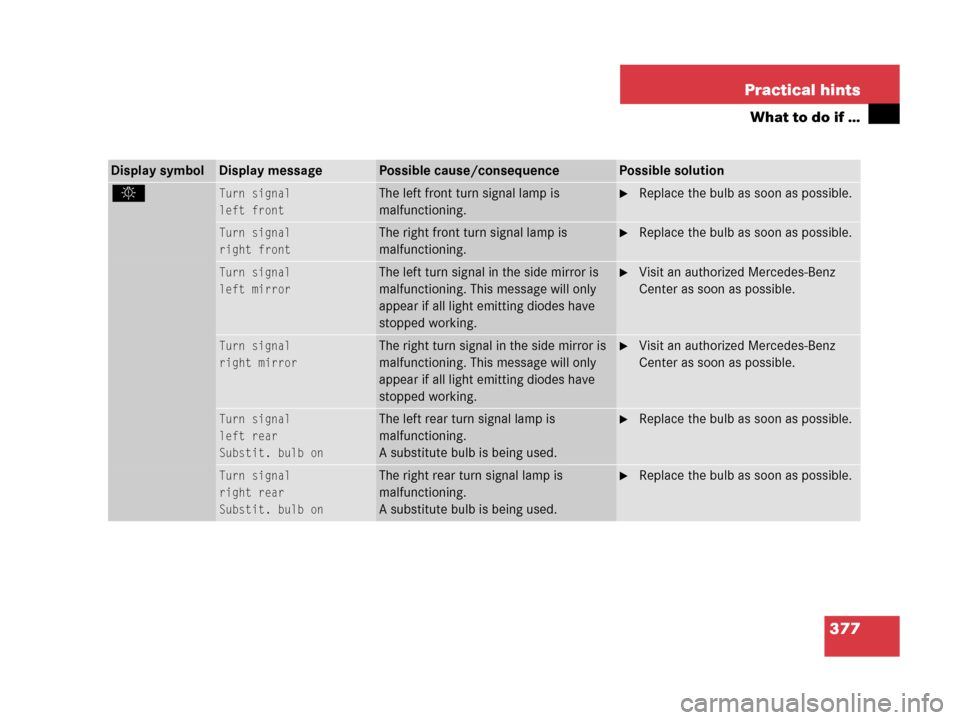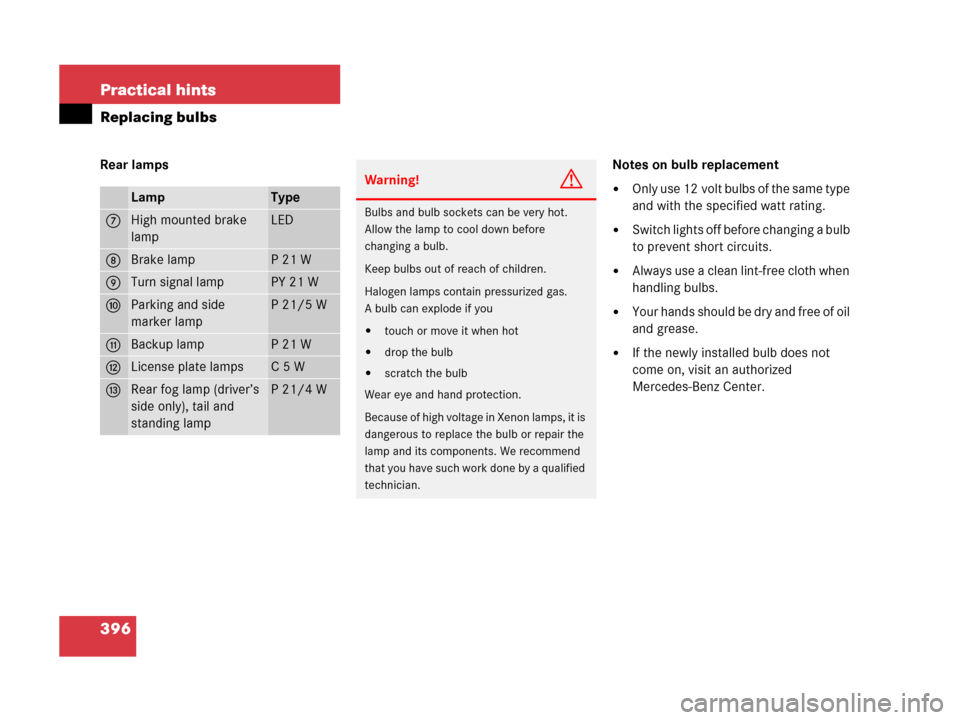Page 276 of 473

275 Controls in detail
Useful features
Step 5:
�After the indicator lamp1 changes
from a slow to a rapidly flashing light,
release the hand-held remote control
button and the signal transmitter but-
ton.Step 6:
�Press and hold the just-trained signal
transmitter button (2, 3 or4) and
observe the indicator lamp1.
If the indicator lamp1 stays on
constantly, programming is complete
and your device should activate when
the respective signal transmitter
button (2, 3 or4) is pressed and re-
leased.Step 7:�To program the remaining two signal
transmitter buttons, repeat the steps
above starting with step 3.
Rolling code programming
To train a garage door opener (or other
rolling code devices) with the rolling code
feature, follow these instructions after
completing the “Programming” portion
(steps 1 through 6) of this text. (A second
person may make the following training
procedures quicker and easier.)
i
The indicator lamp1 flashes immedi-
ately the first time the signal transmit-
ter button is programmed. If this button
has already been programmed, the in-
dicator lamp will only start flashing af-
ter 20 seconds.
i
If the indicator lamp1 flashes rapidly
for about 2 seconds and then turns to a
constant light, continue with
programming steps 8 through 12 as
your garage door opener may be
equipped with the “rolling code”
feature.
Page 277 of 473

276 Controls in detail
Useful features
Step 8:
�Locate “training” button on the garage
door opener motor head unit.
Exact location and color of the button
may vary by garage door opener brand.
Depending on manufacturer, the
“training” button may also be referred
to as “learn” or “smart” button. If there
is difficulty locating the transmitting
button, refer to the garage door opener
operator’s manual.
Step 9:
�Press the “training” button on the ga-
rage door opener motor head unit.
The “training light” is activated.
You have 30 seconds to initiate the follow-
ing two steps.Step 10:
�Return to the vehicle and firmly press,
hold for 2 seconds and release the pro-
grammed signal transmitter button
(2, 3 or4).
Step 11:
�Press, hold for 2 seconds and release
same signal transmitter button a sec-
ond time to complete the training pro-
cess.Step 12:
�Confirm the garage door operation by
pressing the programmed signal trans-
mitter button (2, 3 or4).
Step 13:
�To program the remaining two signal
transmitter buttons, repeat the steps
above starting with step 3.
Gate operator/Canadian programming
Canadian radio-frequency laws require
transmitter signals to “time-out” (or quit)
after several seconds of transmission
which may not be long enough for the
integrated signal transmitter to pick up the
signal during programming. Similar to this
Canadian law, some U.S. gate operators
are designed to “time-out” in the same
manner.
i
Some garage door openers (or other
rolling code equipped devices) may re-
quire you to press, hold for 2 seconds
and release the same signal transmit-
ter button a third time to complete the
training process.
Page 345 of 473

344 Operation
Vehicle care
Ornamental moldings
For regular cleaning and care of ornamen-
tal moldings, use a damp cloth.Headlamps, tail lamps, side markers,
turn signal lenses
�Use a mild car wash detergent, such as
Mercedes-Benz approved Car Sham-
poo, with plenty of water.
!
Due to the width of the vehicle, fold in
exterior rear view mirrors prior to run-
ning the vehicle through an automatic
car wash to prevent damage to the
mirrors.
Make sure that the windshield wiper
switch is set to0 (
�page 50). Other-
wise, the rain sensor could activate and
cause the wipers to move unintention-
ally. This may lead to vehicle damage.
i
After running the vehicle through an au-
tomatic car wash, wipe any wax off of
the windshield (
�page 345). This will
prevent smears and reduce wiping
noise which can be caused by residual
wax on the windshield.
When leaving the car wash, make sure
that the mirrors are folded out. Other-
wise they may vibrate.
!
Do not use chrome cleaner on orna-
mental moldings. Although ornamental
moldings may have chrome appear-
ance, they could be made of anodized
aluminum that will be damaged when
cleaned with chrome cleaner. Instead,
use a damp cloth to clean those orna-
mental moldings.
For very dirty ornamental moldings of
which you are sure are chrome-plated,
use a chrome cleaner. If in doubt
whether an ornamental molding is
chrome-plated, contact an authorized
Mercedes-Benz Center.!
Only use window cleaning solutions
that are suitable for plastic lamp lens-
es. Window cleaning solutions which
are not suitable may damage the plas-
tic lamp lenses of the headlamps.
Therefore, do not use abrasives, sol-
vents or cleaners that contain solvents.
Never apply strong force and only use a
soft, non-scratching cloth when clean-
ing the lenses. Do not attempt to wipe
dirty lenses with a dry cloth or sponge.
Otherwise you may scratch or damage
the lens surface.
Page 360 of 473

359 Practical hints
What to do if …
On the pages that follow, you will find a
compilation of the most important warning
and malfunction messages that may
appear in the multifunction display.
For your convenience the messages are
divided into two sections:
�Text messages (�page 360)
�Symbol messages (�page 365)
Warning!G
No messages will be displayed if either the
instrument cluster or the multifunction
display is inoperative.
As a result, you will not be able to see infor-
mation about your driving conditions, such
as speed or outside temperature, warning/
indicator lamps, malfunction/warning mes-
sages or the failure of any systems. Driving
characteristics may be impaired.
If you must continue to drive, please do so
with added caution. Visit an authorized
Mercedes-Benz Center as soon as possible.
i
Switching on the ignition causes all
instrument cluster lamps (except low
beam headlamp indicator lamp, high
beam headlamp indicator lamp, and
turn signal indicator lamps unless
activated) as well as the multifunction
display to come on. Make sure the
lamps and multifunction display are in
working order before starting your
journey.
Page 378 of 473

377 Practical hints
What to do if …
Display symbolDisplay messagePossible cause/consequencePossible solution
.Turn signal
left frontThe left front turn signal lamp is
malfunctioning.�Replace the bulb as soon as possible.
Turn signal
right frontThe right front turn signal lamp is
malfunctioning.�Replace the bulb as soon as possible.
Turn signal
left mirrorThe left turn signal in the side mirror is
malfunctioning. This message will only
appear if all light emitting diodes have
stopped working.�Visit an authorized Mercedes-Benz
Center as soon as possible.
Turn signal
right mirrorThe right turn signal in the side mirror is
malfunctioning. This message will only
appear if all light emitting diodes have
stopped working.�Visit an authorized Mercedes-Benz
Center as soon as possible.
Turn signal
left rear
Substit. bulb on
The left rear turn signal lamp is
malfunctioning.
A substitute bulb is being used.�Replace the bulb as soon as possible.
Turn signal
right rear
Substit. bulb on
The right rear turn signal lamp is
malfunctioning.
A substitute bulb is being used.�Replace the bulb as soon as possible.
Page 396 of 473
395 Practical hints
Replacing bulbs
Bulbs Front lamps
LampType
1Additional turn signal
lampLED
2Halogen headlamp:
Turn signal lamp
Bi-Xenon* headlamp:
Turn signal lamp
1156 A
2357 A
3Halogen headlamp:
Low beam
Bi-Xenon* headlamp:
Low and high beam
1
1Vehicles with Bi-Xenon* headlamps: Low beam
and high beam use the same D2S-35W lamp. Do
not replace the Xenon bulbs yourself. Contact an
authorized Mercedes-Benz Center.
H7 (55 W)
D2S-35 W
LampType
4Halogen headlamp:
High beam/high beam
flasher
Bi-Xenon* headlamp:
High beam flasher
H7 (55 W)
H7 (55 W)
Parking and standing
lampW5W
5Front fog lampHB4 (51 W)
6Side marker lampW5W
Page 397 of 473

396 Practical hints
Replacing bulbs
Rear lamps Notes on bulb replacement
�Only use 12 volt bulbs of the same type
and with the specified watt rating.
�Switch lights off before changing a bulb
to prevent short circuits.
�Always use a clean lint-free cloth when
handling bulbs.
�Your hands should be dry and free of oil
and grease.
�If the newly installed bulb does not
come on, visit an authorized
Mercedes-Benz Center.
LampType
7High mounted brake
lampLED
8Brake lampP21W
9Turn signal lampPY 21 W
aParking and side
marker lampP 21/5 W
bBackup lampP21W
cLicense plate lampsC5W
dRear fog lamp (driver’s
side only), tail and
standing lampP 21/4 W
Warning!G
Bulbs and bulb sockets can be very hot.
Allow the lamp to cool down before
changing a bulb.
Keep bulbs out of reach of children.
Halogen lamps contain pressurized gas.
A bulb can explode if you
�touch or move it when hot
�drop the bulb
�scratch the bulb
Wear eye and hand protection.
Because of high voltage in Xenon lamps, it is
dangerous to replace the bulb or repair the
lamp and its components. We recommend
that you have such work done by a qualified
technician.
Page 398 of 473
397 Practical hints
Replacing bulbs
Have the LEDs and bulbs for the following
lamps replaced by an authorized
Mercedes-Benz Center:
�Additional turn signals in the exterior
rear view mirrors
�High mounted brake lamp
�Xenon* lamps
�Front fog lamps
�Front side marker lamps
Replacing bulbs for front lamps
Before you start to replace a bulb for a
front lamp, do the following first:
�Turn the exterior lamp switch to
positionM (
�page 114).
�Open the hood (�page 297).
Halogen headlamp
1Housing cover for low beam headlamp
2Housing cover for high beam head-
lamp, parking and standing lamp3Bulb socket for turn signal lamp bulb
4Bulb socket for low beam bulb
5Bulb socket for high beam bulb
6Bulb socket for parking and standing
lamp bulb
i
Have the headlamp adjustment
checked regularly.